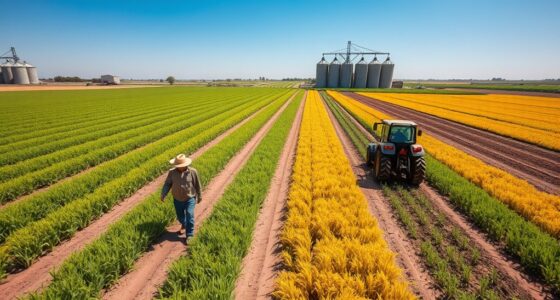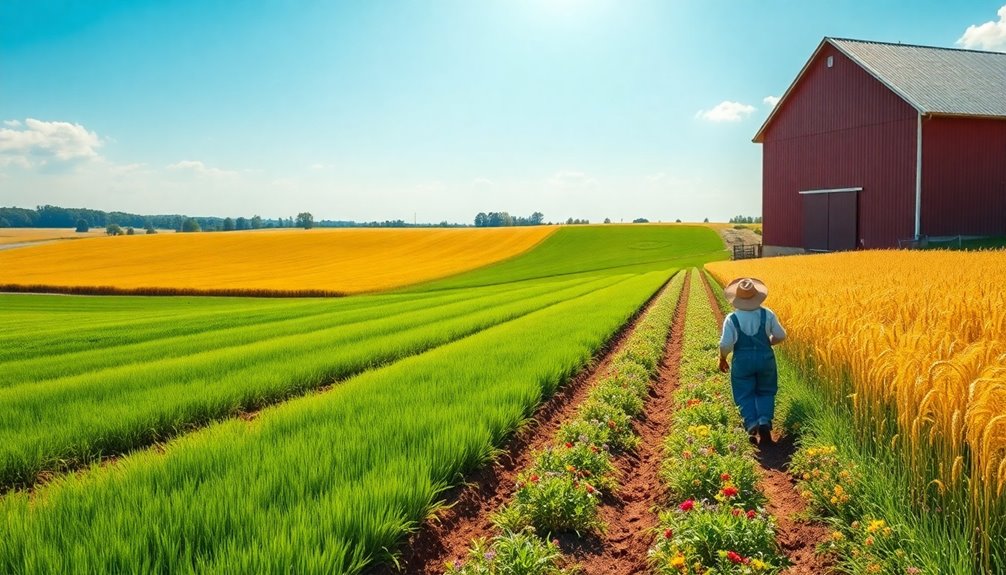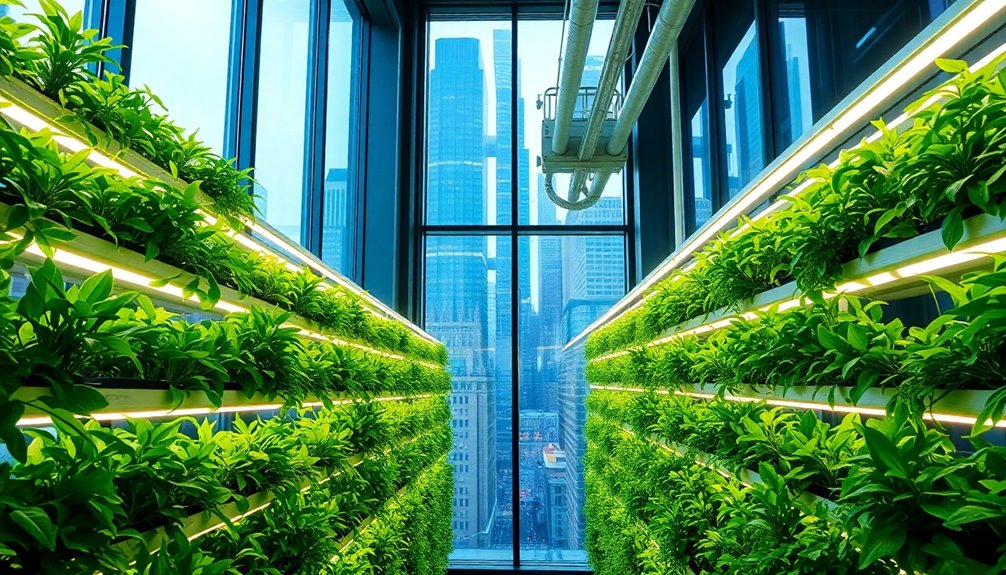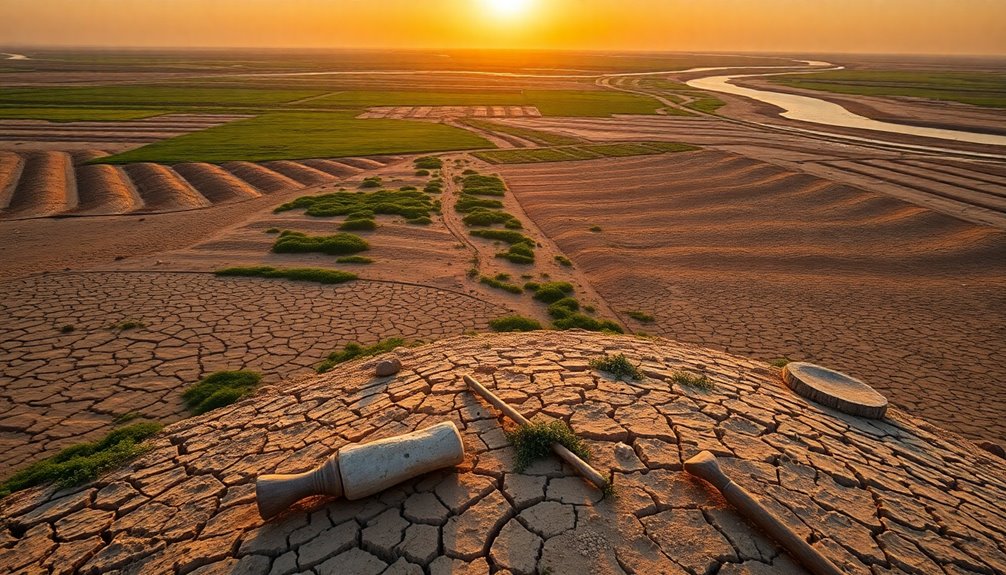Commercial farming is all about producing crops and livestock on a large scale for profit and market demand. You'll find that it uses advanced techniques like GPS-guided tractors and requires significant investment in equipment. This type of agriculture includes dairy, livestock ranching, grain farming, and cash crops. While it contributes significantly to the economy, it also raises environmental and social concerns. By understanding its complexities, you can uncover more about its impact and potential.
Key Takeaways
- Commercial farming focuses on large-scale production of crops and livestock primarily for sale and profit, contrasting with subsistence farming.
- It utilizes advanced technologies and farming techniques to efficiently meet market demands and maximize profitability.
- Types include dairy farming, livestock ranching, grain farming, and plantation farming, each specializing in specific products.
- The sector significantly impacts the economy, contributing to GDP, generating jobs, and enhancing regional economies through agricultural exports.
- Environmental and social considerations include pollution, water usage, and potential labor exploitation, raising concerns about sustainability and community health.
Definition of Commercial Farming

Commercial farming, at its core, focuses on producing crops and livestock primarily for sale and profit. Your goal in commercial farming is to meet market demand and generate income.
Typically, you'll find large-scale production operations, utilizing advanced technologies and modern farming techniques to maximize efficiency and yield. This method significantly impacts the economy by creating jobs and generating revenue.
Large-scale commercial farming employs cutting-edge technologies to enhance productivity, significantly boosting economic growth and job creation.
You might engage in various types of crops, such as cash crops like cotton and tobacco, or grains like wheat and maize. Additionally, commercial farming encompasses livestock production, including dairy and poultry.
This approach stands in stark contrast to subsistence farming, where the primary aim is personal consumption rather than profit. Successful commercial farming often incorporates natural techniques that promote sustainable practices and enhance overall productivity.
Key Features of Commercial Agriculture
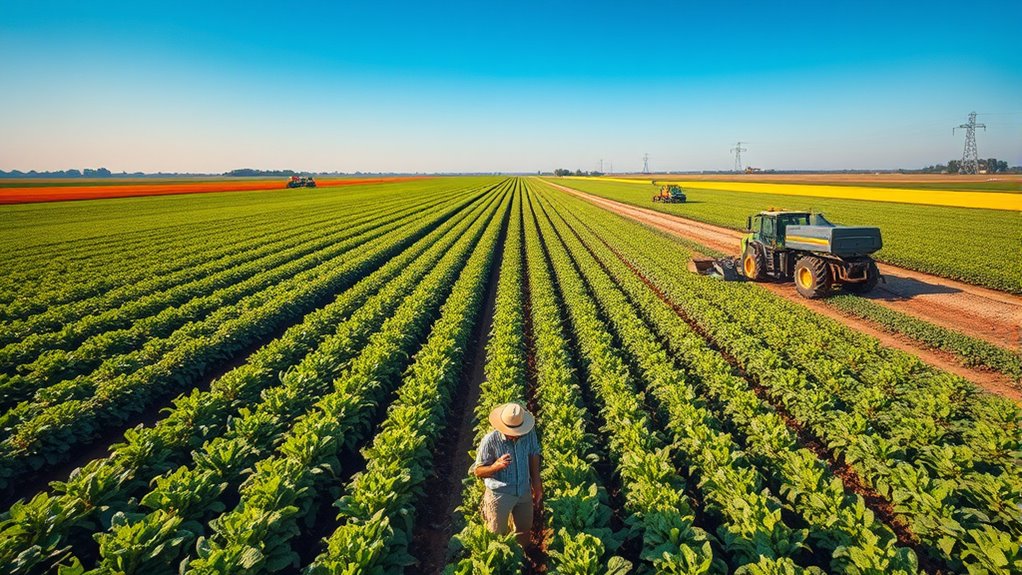
When you delve into commercial agriculture, you'll notice several key features that set it apart from other farming methods. This type of farming typically involves large-scale operations, focusing on cultivating vast areas to meet market demands efficiently.
You'll find that economies of scale play a crucial role, allowing for cost advantages through bulk purchasing and mechanization. Advanced farming techniques, like GPS-guided tractors and high-yielding crop varieties, enhance productivity.
Additionally, production is market-oriented, emphasizing crop selection based on profitability. You'll also see significant capital investment in equipment and infrastructure, ensuring year-round production.
While it contributes greatly to a country's GDP and food security, the industry faces challenges like environmental impacts and market fluctuations.
Types of Commercial Agriculture
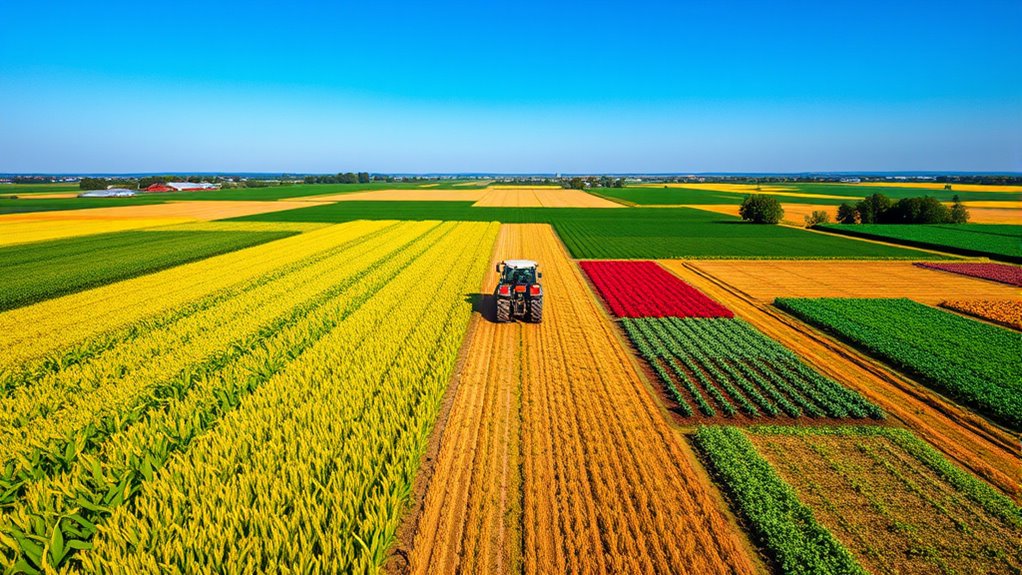
Understanding the various types of commercial agriculture helps you appreciate the diversity and specialization within the industry.
You'll encounter dairy farming, where cows, buffaloes, and goats are raised for milk, and livestock ranching, focusing on cattle, sheep, and pigs for meat.
Grain farming produces staples like wheat and corn, while plantation farming grows cash crops such as coffee and cocoa.
Mixed crop and livestock farming maximizes resource use effectively.
Additionally, regional specializations include Mediterranean agriculture with figs and olives, tropical plantation farming for rubber and palm oil, and aquaculture for aquatic products.
You'll also find organic farming emphasizing sustainability, alongside specialty crops that thrive in specific climates, showcasing the vast opportunities within commercial agriculture.
Economic Impact of Commercial Farming
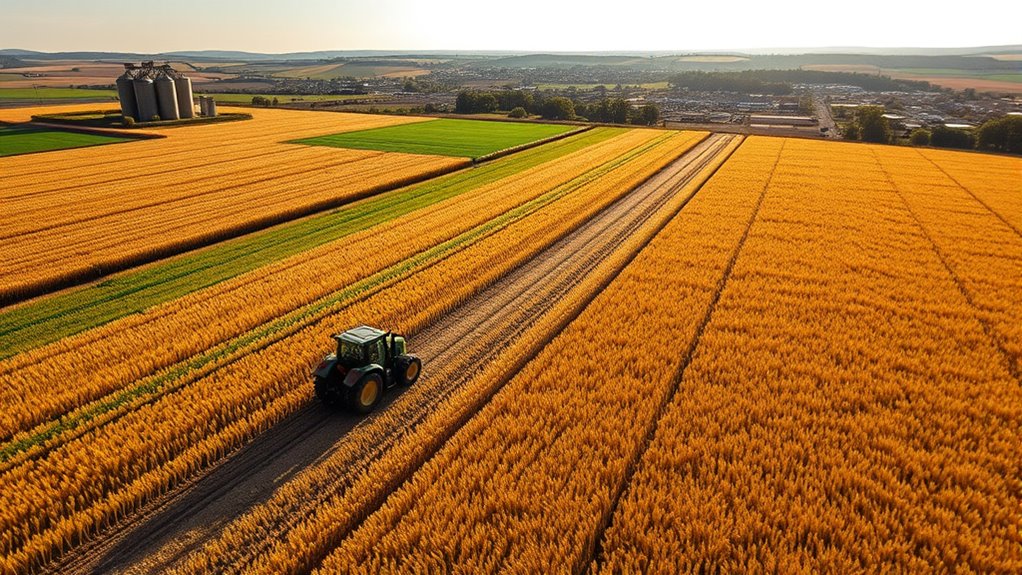
While examining the economic impact of commercial farming, you'll quickly realize its profound influence on both local and global economies.
Agriculture contributes around 4% to global GDP and significantly boosts the U.S. economy, accounting for $1.53 trillion and 5.6% of its GDP in 2023.
With over 34 million jobs supported in the U.S., commercial farming creates diverse employment opportunities, from farm labor to management roles.
It enhances regional economies, generating billions in direct sales.
Moreover, agricultural exports, which reached $197.4 billion in 2022, stimulate additional economic activity.
As commercial farming adapts to market demands, it drives economic growth, offering investment opportunities and contributing to financial stability through export earnings. The continuous learning necessary in the agricultural sector helps farmers innovate and improve productivity, further boosting economic contributions.
Environmental and Social Considerations
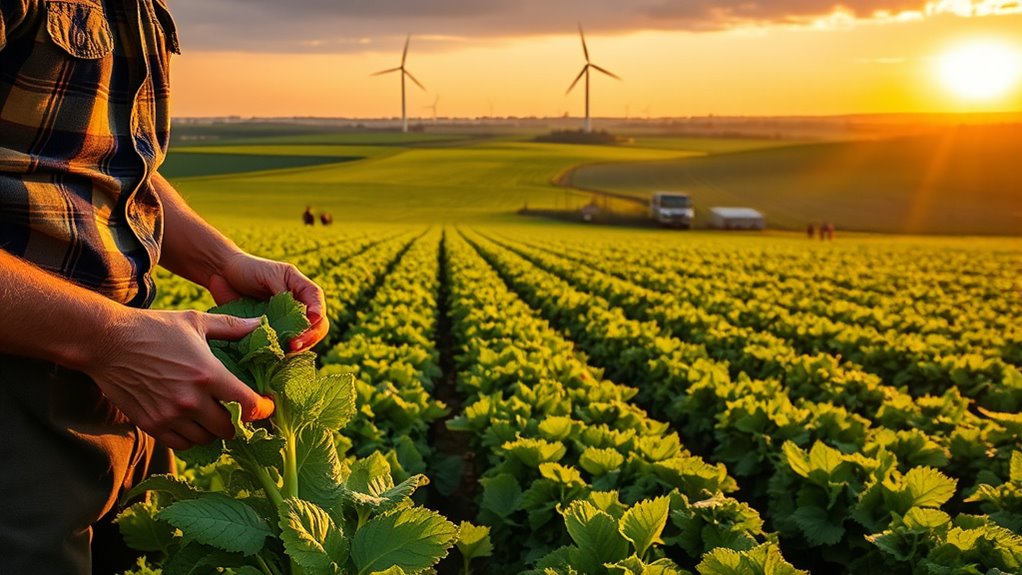
Commercial farming significantly impacts both the environment and society, raising important considerations for sustainability. It contributes to pollution through pesticides and fertilizers, harming freshwater and marine ecosystems. Additionally, agriculture consumes about 69% of the world's fresh water, affecting vital freshwater systems.
Climate change is also a concern, with livestock alone responsible for 18% of global emissions.
Socially, commercial farming can lead to labor exploitation and changes in rural economies, often depopulating communities. While it plays a crucial role in food security, unsustainable practices can deepen poverty for many reliant on farming for their livelihoods.
Furthermore, pollution from agricultural activities can adversely affect the health of nearby communities, highlighting the urgent need for sustainable practices.
Challenges and Opportunities in Commercial Farming
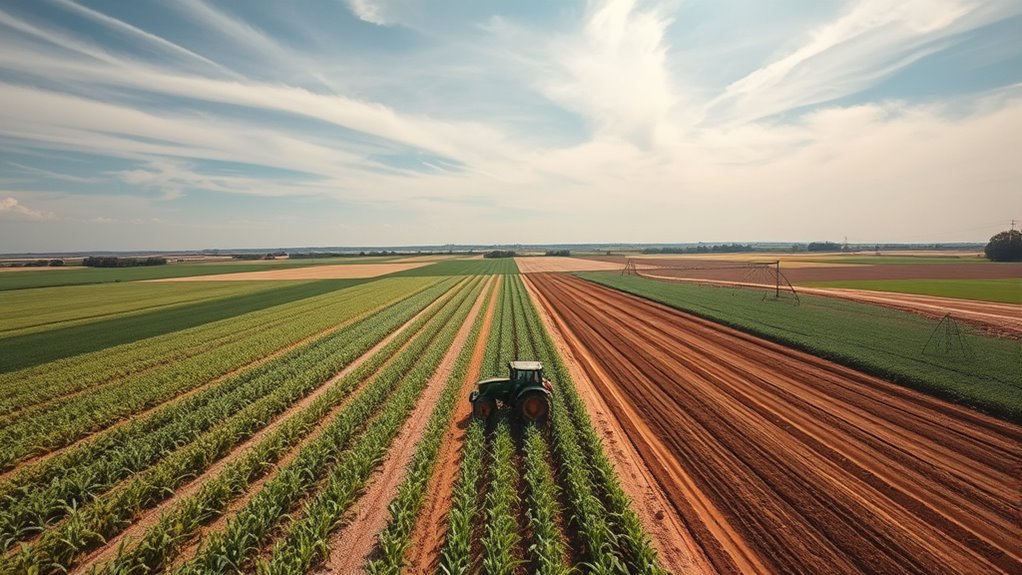
As global competition intensifies, commercial farmers navigate a complex landscape of challenges and opportunities that can significantly influence their success.
Price volatility and shifting consumer trends can disrupt your planning, while the high costs of inputs and limited access to capital strain your finances. Climate change and supply chain disruptions further complicate operations, making adaptability crucial.
However, technological advancements like precision farming and automation offer solutions to enhance efficiency and yield. The growing global population presents a chance to meet rising food demand, and engaging in diversified operations can mitigate risks.
Frequently Asked Questions
How Does Commercial Farming Differ From Subsistence Farming?
Commercial farming differs from subsistence farming primarily in scale and intent.
While you focus on producing enough for your family's needs in subsistence farming, commercial farming aims to generate profit through large-scale production.
You'll notice that commercial farms rely on advanced technology, specialize in specific crops or livestock, and are deeply integrated into global markets.
This means they're often influenced by market demands and fluctuations, unlike the more self-sufficient approach of subsistence farming.
What Technologies Are Commonly Used in Commercial Agriculture?
In the world of commercial agriculture, technology's your best friend!
You'll find drones soaring above fields, monitoring crop health and spotting pests. Precision agriculture lets you tailor inputs exactly where needed, while soil moisture sensors optimize irrigation.
Robotic harvesters and autonomous tractors take the grunt work off your hands, boosting efficiency. With AI analyzing data, you'll make smarter decisions that lead to bountiful harvests and healthier crops.
Embrace these innovations for a thriving farm!
What Are the Major Global Markets for Commercial Agricultural Products?
When you think about the major global markets for commercial agricultural products, consider the Americas, Asia Pacific, Europe, and the Middle East and Africa.
The Americas lead with advanced farming technologies, while Asia Pacific is set to grow rapidly due to rising food demand.
Europe focuses on sustainability, and the Middle East and Africa see increasing investments in agriculture.
These regions play pivotal roles in shaping agricultural trade and meeting global food needs.
How Do Government Policies Affect Commercial Farming Practices?
Imagine navigating a maze where each turn is dictated by a signpost. Government policies act as those signposts, guiding your commercial farming practices. They influence everything from crop choices to labor availability.
For instance, if tariffs rise, your export opportunities might dwindle, impacting profits. Conservation incentives could encourage sustainable methods, while tax policies might lighten your financial burden.
Staying informed about these regulations helps you steer your farm toward success amidst shifting landscapes.
What Role Do Consumer Preferences Play in Commercial Farming?
Consumer preferences significantly shape commercial farming by driving demand for healthy, organic, and minimally processed foods.
You notice farmers adapting their practices to meet your desire for sustainable and traceable products. As you prioritize nutritional value and ethical sourcing, they diversify crops and adopt environmentally friendly methods.
Conclusion
In summary, commercial farming plays a vital role in feeding the world and driving economies. Did you know that about 80% of the world's food supply comes from just 20% of the world's farms? This statistic highlights the efficiency and impact of commercial agriculture. While it presents challenges like environmental concerns, it also offers opportunities for innovation and growth. By understanding commercial farming, you're better equipped to appreciate its significance in our daily lives and the global economy.



